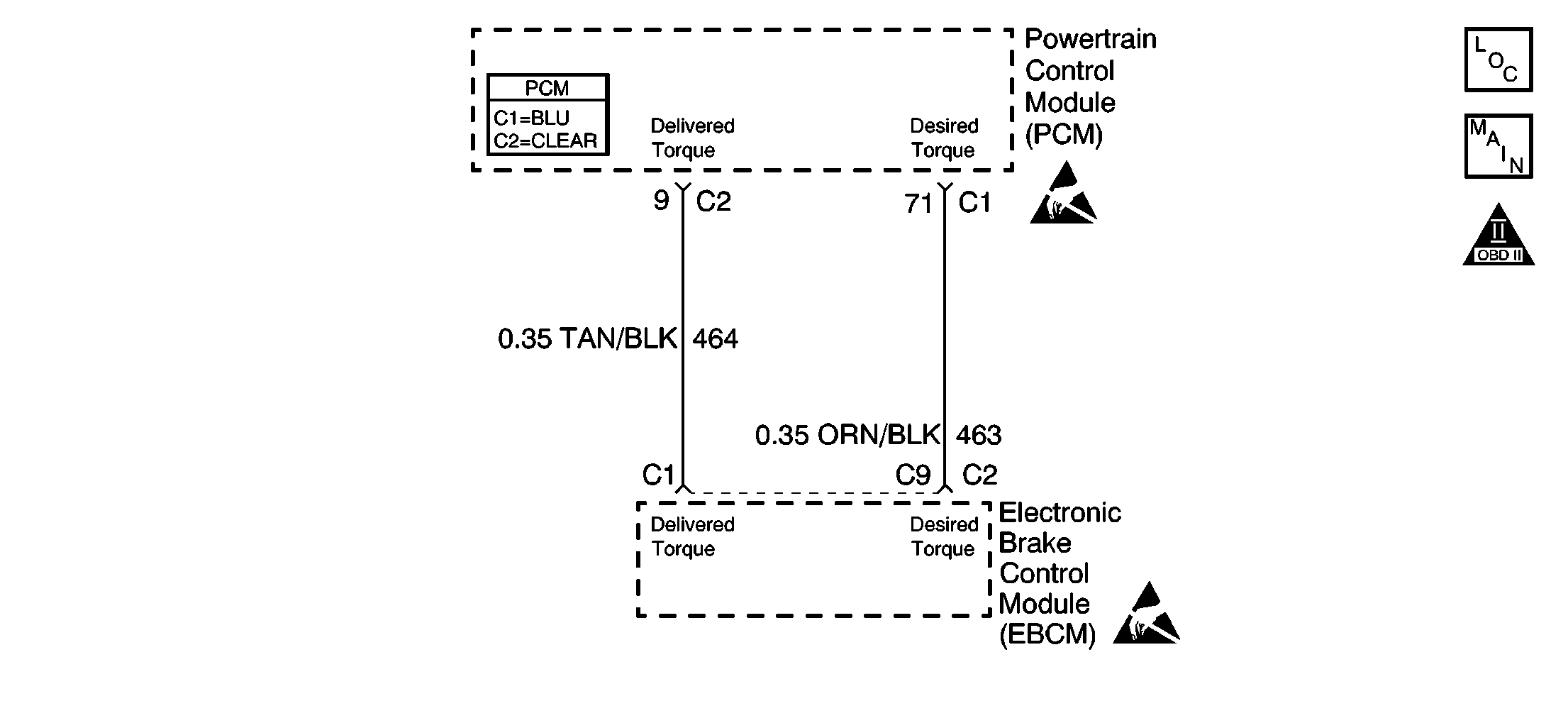
Circuit Description
The traction control system (TCS) uses the antilock brake system in conjunction with the powertrain control module (PCM) fuel and ignition controls to limit drive wheel slippage during acceleration. The PCM controlled portion of the TCS reduces engine torque by any or all of the following methods:
| • | Retarding spark timing |
| • | Altering air/fuel ratio |
| • | Shutting off up to 3 injectors |
To determine the amount of torque reduction required, the PCM monitors the TCS desired torque pulse width modulated (PWM) signal from the electronic brake and traction control module (EBTCM). The PCM also provides a TCS delivered torque PWM informing the EBTCM how much torque is being produced by the engine. The Desired Torque display on the scan tool indicates the amount of engine torque requested by the EBTCM. With the traction control inactive, the desired torque should vary between 99 and 100 percent. The Desired Torque display on the scan tool is not the PWM duty cycle.
Conditions for Setting the DTC
| • | The desired torque signal PWM duty cycle is less than 10 percent or more than 95 percent. |
| • | The above condition is present for at least 10 seconds. |
Action Taken When the DTC Sets
The PCM stores conditions which were present when the DTC set as Failure Records only. This information will not be stored as Freeze Frame Records.
Conditions for Clearing the MIL/DTC
| • | The DTC becomes history when the conditions for setting the DTC are no longer present. |
| • | The history DTC clears after 40 malfunction free warm-up cycles. |
| • | The PCM receives a clear code command from the scan tool. |
Diagnostic Aids
Inspect the following conditions:
Many situations may lead to an intermittent condition. Perform each inspection or test as directed.
Important: : Remove any debris from the connector surfaces before servicing a component. Inspect the connector gaskets when diagnosing or replacing a component. Ensure that the gaskets are installed correctly. The gaskets prevent contaminate intrusion.
| • | Loose terminal connection |
| - | Use a corresponding mating terminal to test for proper tension. Refer to Testing for Intermittent Conditions and Poor Connections , and to Connector Repairs in Wiring Systems for diagnosis and repair. |
| - | Inspect the harness connectors for backed out terminals, improper mating, broken locks, improperly formed or damaged terminals, and faulty terminal to wire connection. Refer to Testing for Intermittent Conditions and Poor Connections , and to Connector Repairs in Wiring Systems for diagnosis and repair. |
| • | Damaged harness--Inspect the wiring harness for damage. If the harness inspection does not reveal a problem, observe the display on the scan tool while moving connectors and wiring harnesses related to the sensor. A change in the scan tool display may indicate the location of the fault. Refer to Wiring Repairs in Wiring Systems for diagnosis and repair. |
| • | Inspect the powertrain control module (PCM) and the engine grounds for clean and secure connections. Refer to Wiring Repairs in Wiring Systems for diagnosis and repair. |
If the condition is determined to be intermittent, reviewing the Snapshot or Freeze Frame/Failure Records may be useful in determining when the DTC or condition was identified.
Step | Action | Value(s) | Yes | No |
|---|---|---|---|---|
1 | Did you preform the Powertrain On-Board Diagnosis (OBD) System Check? | -- | ||
2 |
Is (Traction Control) Desired Torque at or near the specified value? | 100% | ||
3 |
Does voltage measure the specified value? | 5.0 V | ||
4 |
Is frequency between the specified values? | 120-135 Hz | ||
5 |
Is duty cycle between the specified values? | 10-95% | ||
6 |
Did you find and correct the condition? | -- | ||
7 | Test for a poor connection at the EBTCM. Refer to Testing for Intermittent Conditions and Poor Connections in Wiring Systems. Did you find and correct the condition? | -- | ||
8 | Replace the EBTCM. Refer to Electronic Brake Control Module Replacement in ABS/TCS. Did you complete the repair? | -- | -- | |
9 | Test for a poor connection at the PCM. Refer to Testing for Intermittent Conditions and Poor Connections in Wiring Systems. Did you find and correct the condition? | -- | ||
10 |
Important: : The replacement PCM must be programmed. Replace the PCM. Refer to Powertrain Control Module Replacement/Programming .Did you complete the repair? | -- | -- | |
11 |
Is (traction control) Desired Torque at or near the specified value? | 100% | System OK |
